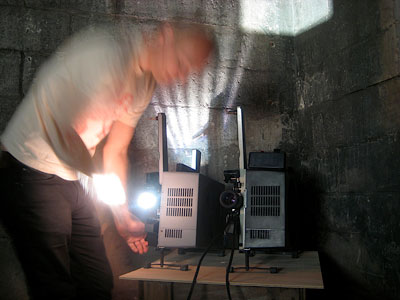Exploring the Fallacy of Perception through Light and Sound
 by Brandon Kosters
by Brandon Kosters
Working with handmade electronics, guitar effect pedals, and an oscillator, Joe Grimm translates light from two film projectors into sound. He has modified these projectors so that he can adjust the frame rate the projectors run at with knobs, producing erratic flickers of light that correspond to ambient noise. “It’s about synesthesia,” Grimm says. “Totally collapsing the two into one experience.”
Grimm, a graduate student at SAIC, first approached this method of working while on tour with his friend, filmmaker Ben Russell. “We tried to come up with ways of translating flickers he would make with a projector into sound. We formed a duo called Mazes, where he would run the projector in the back, and I stood at the screen with sensors and electronics. It was about sharing the control of the sound.”
Much of Joe’s collaborative work seems to directly address this issue of “shared control.” Grimm said, “ One of the projects I’m involved with now with sculptor Lauren Carter is a project called Mirror Phase. It’s a similar process but without projectors. We use feedback units and we can send sound to each other. This process of eclectically merging two different sounds.”
Grimm, who is also a musician who plays more traditional instruments, went on to discuss the ways that a collaboration of this nature differs from and is similar to a more conventional musical collaboration. “It’s similar in terms of listening and attunement and trying to come into balance with the other person. It’s different, in that the [sound device] is sort of alive and will perform it’s own fluctuations on it’s own. You are more herding it than you are controlling it.”
This notion of forfeiting control over the medium seems to stimulate Grimm. “I’m interested in something that rather than just responding to my own will, exerts it’s own pressure back and will act as more of a partner. With the projectors, the frame rate is randomized. I never know exactly what it will do. I have control of the general arch, but the moment to moment thing is out of my control.”
Grimm did his undergraduate study at Yale. He majored in philosophy, and this informed his trajectory. “I was really interested in Kant’s distinction between the world of things themselves and things as we perceive them, and how we can never really know which is the real thing. I think over time you question what your senses are taking in. It becomes unclear whether you’re hallucinating a sound or an image, or is it really there?”
“It’s a crazy thing that happens with your eyes when you’re on the boundary of experiencing something as a flicker and seeing something as a solid pane of light.”
This issue of visibility vs. invisibility is also applicable to the sound element of the work. “ A lot of what you’re hearing is the result of sound being produced far above our hearing range. The oscillators are ultrasonic. When two projectors are making ultrasonic pitches, it produces a third resultant pitch that we can hear. It’s like a ghost that appears as a result of the interaction of tones that are outside of our range of hearing.”
Every viewer can project or perceive something unique. “Some people will say they see certain colors, or triangles or squares. I see purpley blobs. We all have different eyes.”
Grimm performs “anywhere with a good sound system and something white to project onto.” He has played alongside experimental musicians on numerous occasions, and says that they are frequently more responsive to his work than filmmakers are.
“I think it’s different than people who come at it from more of a film perspective,” says Grimm. Film people think about the history of film and the issues that that brings. That’s a totally different set of concerns. In the experimental sound context, people are less attached to the ideas of narrative and more into the idea of pure sense experience.”
It was less an interest in cinema, and more of an interest in enriching his sound performances that propelled Grimm towards producing this body of work. Grimm says that he is “ultimately a person who thinks about sound first. This comes out of a concern about electronic music. If I have a bunch of pedals plugged into an oscillator, that is going to provide for a very different sort of performance than if I am playing a violin. Part of what brought me to this [process] was thinking about ways that electronic music is presented.”







